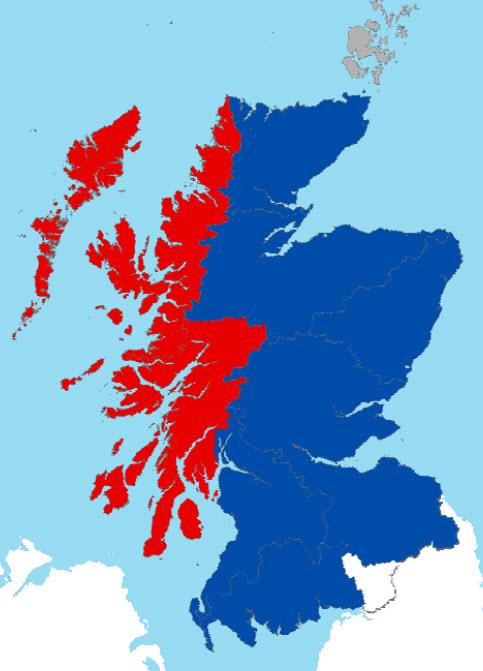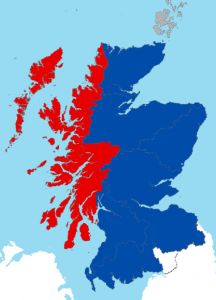A very unbalanced view: We have previously mentioned that Salmon & Trout Conservation refuse even to engage in discussion about salmon farming. OneKind have adopted a similar approach. Now Green MSP Mark Ruskell has sent us an unsubscribe message to remove him from the reLAKSation mailing list. He clearly doesn’t want to hear an alternative view to his own. After all, it might undermine the content on the motion he has lodged with the Scottish Parliament. Whilst he isn’t keen on hearing from the salmon industry, he appears happy to talk to Don Staniford (https://vimeo.com/293902162).
Mr Ruskell has featured in the Scotsman saying that the public awareness of the damage caused by salmon farming is growing and the latest news form SEPA that many are failing to meet even the lowest standards must be of concern. This follows the news that 56 of the 297 farms were rated poor or below. The Scotsman say that some of the reasons cited by SEPSA included excessive ammonia, and excessive waste around the cages. What is not mentioned is that salmon are very intolerant of poor conditions.
The Times also reported this news and pointed out that data has not been handed in on time was also cited as a reason for not reaching the required standard. Whilst it is regrettable for any farm not to reach the accepted standard, delays in supplying data is not exactly harmful to the environment.
The problem is that rather than being willing to discuss these issues, Mr Ruskell simply wants to penalise the industry. It’s a shame, he is so reluctant to find out more.
Whilst, Mr Ruskell highlights the damage that salmon farming is supposedly causing to the environment, the Times has reported on new research about environmental damage. The Natural History Museum conducted trawls of the Firth of Clyde and found that 39% of fish and shrimp caught were found to have eaten plastic. Up to 23 different pieces of plastic were found in species such as flounder, dab, pouting, dogfish and shrimp.
Alexandra McGoran, one of the authors of the study said that the plastic was unlikely to be fatal but could affect the growth of the fish and their ability to reproduce. She said that this new research shows why plastic is such a pressing issue. The Clyde estuary is an extremely diverse ecosystem and home to hundreds of species. She said that to see this large number of species put in danger by plastic pollution is actually rather shocking.
Paul Clark, a co-author said that the depressing aspect of this research is that the plastic pollution is probably now irreversible, and its presence may persist for many generations. He added that plastic pollution is on the same calamitous magnitude as climate change and deforestation, not something Mr Ruskell can say about salmon farming (although he’ll probably try).
History lesson: Salmon farming critics from the angling sector claim that the high levels of sea lice found on some wild fish are the result of the presence of salmon farms. They claim that high lice levels and subsequent mortality only occur as a result of salmon farming and never occurs naturally.
We might suggest that as salmon farms are the target of their criticism, the focus is always in salmon farming areas and not elsewhere. How much sea lice research is conducted on the east coast. There are a handful of papers that have compared sea lice counts around Scotland, but these are hardly ever mentioned. However, of much more interest is a paper from Canada from 1940.
As far as we are aware salmon farming did not exist in 1940, either in Canada, Scotland or even Norway so observations of infestations of sea lice are clearly a natural phenomenon.
The paper by H. C. White of the Atlantic Biological Station in Nova Scotia, recorded sea lice in the Moser river. He reported that ‘salmon trapped when ascending the Moser in the summer of 1939 all either carried lice or had scars caused by lice. The earliest running fish were slightly infested and showed no noticeable abrasions but as the season progressed the lice became more numerous and the abrasions more severe. The larger salmon were not as heavily infested as the grilse. The infestation appeared to reach its peak in the middle of August both in terms of the number of lice and the severity of the abrasions. At this time, fish carried hundreds of sea lice ranging in body length from 3 to 12 mm. Some of the grilse had almost a complete layer of lice extending from the posterior edge of the eyes to the caudal peduncle on the dorsal part of the body with a few lice around the anal and pelvic fins.’
In August 1939, ‘a grilse hooked at the upper end of the Moser was found so heavily infested with Lepeophtheirus that its body colours from above were obscured by the brown parasites. The lice covered the head from the eyes backward and extended downward over the opercula and even the posterior part of the eyes was covered.’
According to Dr White, ‘salmon ascended the lower part of the river on August 6th and quite a number of them died during the afternoon. Temperatures were elevated that day. About a dozen of the dead salmon were examined and all showed the light-coloured abraded areas caused by lice. He said that doubtless this contributed to their death.’
Dr White reported that ‘practically all the salmon running during July and up until August 6th were badly infested with the parasites and the later ones showed white patches over the frontal region, on the opercula, along the occipital region and extending posteriorly along the nape.’
Some days after the run on August 6th a local resident reported ‘seeing fish with bright red heads, but Dr White did not see these himself. Although a few days later dying grilse were found in the same vicinity with the same condition. The skin from the nape, the occiput and part of the frontal region had sloughed away revealing the naked reddish flesh beneath.’
Dr White reported that ‘the distinct white area seen had previously been described in 1905 by Calderwood in the Annual Report of the Fisheries Board of Scotland., Dr White said that Calderwood’s description leaves little doubt that this is identical to the observations of the Moser river. Calderwood had found the fish were affected when water was low, and salmon were prevented from ascending the river.’
What is surprising is that we have not recovered Dr White’s paper from obscurity. It is cited in several other papers that we know of, and possibly many more. Of course, like other papers that question some of the claims made by the anti-salmon farm lobby, these papers are often suppressed.
The observations made by Dr White in the Moser river occurred before modern salmon farming was even conceived. These fish were not infested by salmon farming. If salmon can succumb to lice emanating from the natural environment in 1939, then they could do so in 2018 too.
As we have repeatedly argued, the salmon farming industry is often denied the opportunity to highlight the significant discrepancies made by the anti-salmon farming lobby. It’s not surprising that they refuse to meet us to discuss these issues.
Martin’s Blog 2: In last week’s blog, I discussed the relationships between well-known anti-salmon farming activists, funders of anti-salmon farming research and the main author of a paper that apparently shows declines of wild fish stocks with increasing farmed salmon production. The paper by Ford and Myers is cited by Marine Scotland Science in the summary of science about the impacts of sea lice on wild fish stocks on the Scottish Government website.
Marine Scotland Science also quote a second paper in their summary of the sea lice science. This is Vøllestad et al 2009. Marine Scotland Science say that the authors found that declines in catches of wild salmon had been steeper on the Scottish west coast than elsewhere in Scotland, although they stressed that this did not prove a causative link with aquaculture. Unlike the Ford & Myers paper, whose authors were based thousands of miles from Scotland, three of the seven authors of the Vøllestad paper were from Scotland and worked at the Freshwater Fisheries Laboratory at Pitlochry, now part of Marine Scotland Science. The lead Scottish author is Dr John Armstrong who is cited on the Scottish Government website as the Freshwater Fisheries Programme Manager and is listed as the advisor to Government Policy Divisions.
Unlike the Ford & Myers paper, the Vøllestad team do not appear to have links to the anti-salmon farming sector and this specific research was funded by the Norwegian Research Council. Thus, I would hope that the research presents a much more balanced view of the state of salmon stocks.
The paper states that there has been recent concern about the declines of wild salmon throughout its range and the intention of the research was to analyse ‘variations in patterns of population strength to establish the generality of perceived declines’. This was to be achieved by using the most ‘robust groups of time series data’ available. This takes the form of catch statistics from rod fisheries in both Norway and Scotland to examine trends over a range of different areas.
I would like to point out that the data used for Scotland is exactly the same data that I have been using for my own analyses. However, whilst reading through the paper I began to have a growing number of concerns.
The authors state that the Scottish catch statistics comprise of data from 48 rivers over 51 years (1952-2002) and that the rivers were grouped into three sectors: eastern rivers draining to the North Sea (Tweed to Wick), northern rivers draining into the Atlantic Ocean (Thurso to Ormsary) and western rivers draining to the Irish Sea (Ayr to the Nith). They have included a diagram to show these three sectors.
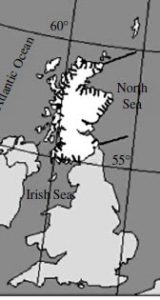
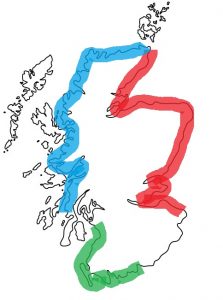
The image from the paper is not exactly clear as to the division of each sector so I have included my own map to show the approximate area covered by the three groups. Some observers might describe me as being pedantic, but I believe there is a problem with the way Scotland has been divided by the authors. The eastern rivers clearly run up the length of the east coast and drain into the North Sea. However, the northern rivers include much of the west coast, whilst the western rivers cover most of the south-west. In addition, most of the northern sector does not drain into the Atlantic Ocean and much of the western sector does not drain into the Irish Sea.
A better representation might be:
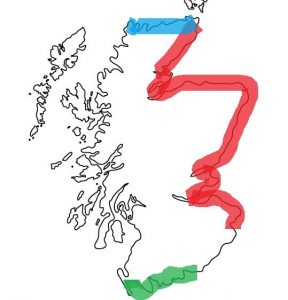
This is because according to The International Hydrographic Organisation – Limits of Oceans and Seas http://www.iho.int/iho_pubs/standard/S-23/S-23_Ed3_1953_EN.pdf the rivers on the west coast do not empty into the Atlantic Ocean but into the ‘Inner Seas’. This consist of the ‘The Minch’, the ‘Little Minch’ and the ‘Sea of the Hebrides’. Equally, most of the rivers classed as western don’t empty into the Irish Sea which is actually further south.
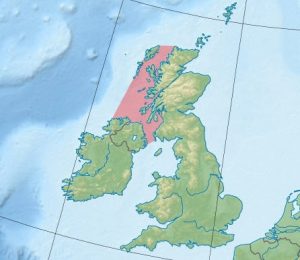
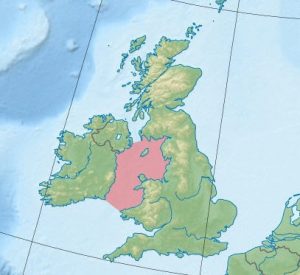
This may be considered to be nit-picking, but it is a scientific paper and should be accurate. Whilst, I realise that this research was not intended to target salmon farming as a reason for any declines in wild fish, any suggestion it has is flawed. The researchers conclude that catches from the Atlantic sector have declined more steeply than from the other two. However, the Atlantic sector as determined by the researchers includes the northern coast, which does not support the salmon farming industry. The aquaculture zone, as it is known, is specifically identified as that on the west coast. This can be seen from a map drawn up by Marine Scotland Science in another publication.
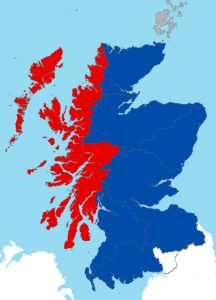
The north coast can be seen to be devoid of the salmon farming industry (red). The north coast rivers are likely to be very different to those within the aquaculture zone primarily because they empty into a very exposed environment. This point has even been made by Andrew Graham Stewart of Salmon & Trout Conservation in an article in ‘Trout & Salmon’ magazine. He says that the exposed coast is the reason why catches from northern rivers are much better than from within the aquaculture zone.
Whilst the divisions between the sectors is of concern, a greater issue is the selection of the rivers to be analysed within each sector. The authors state that 48 rivers were selected, which equates to just 16 rivers or fishery districts in each sector. The aquaculture zone covers an area consisting of 61 fishery districts so using just 16 for that area and the northern coast together might indicate a deficiency of catch data. It seems that the researchers were trying to select the rivers so that they were a similar distance apart from adjacent rivers. The problem is that not all rivers are equal, and I know from my own research that one river can produce healthy catches whilst catches from the next river up the coast are exactly the opposite. It is possible to produce data from the aquaculture zone which would suggest that catches have collapsed whilst other rivers might be doing extremely well. This is why, in my research, I have included data from all 109 fishery districts.
As already mentioned, the researchers conclude that although catches have declined across all three sectors, catches have declined more steeply in the Atlantic sector. They suggest that although other explanations are possible, some of the differences between the Atlantic sector and the other sectors may be due to the effects of intensive salmon aquaculture on affected rivers. Yet, clearly, the Atlantic sector includes rivers that have not been exposed to any salmon farming. I therefore question the implied link to aquaculture as a possible reason for the decline. As they say, this does not mean that there is a causative link but for anyone reading the paper, the inference is that salmon farming is to blame, when clearly there is no proof of this at all.
The results displayed in the paper do not help. These are displayed in three graphs although only one relates to Scotland.
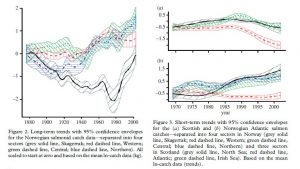
The Scottish data is displayed in the top right-hand graph. The Atlantic sector appears in red and can be seen to dip although as there is no description of the axis, it is unclear how they relate to the actual data. I have included the long-term and short-term graphs for Norwegian rivers because they illustrate my concern about the way the data is managed. Norway has collected data for well over a hundred years although it was not until the 1970s that the data for each species was separated. The authors of this paper have analysed the Scottish data since 1970 so it can be compared to that from Norway but what is interesting is how the graphs for Norway appear to change when displayed over the two periods. The black line is well below the others in the long-term display but appears to parallel the others when displayed as short-term. The question is would similar changes occur if the Scottish data was treated in the same way. As I have previously mentioned, Scottish data has been collected since 1952 but the time prior to 1970 has been omitted.
I have drawn my own graph of catches from the rivers selected for the whole time series:
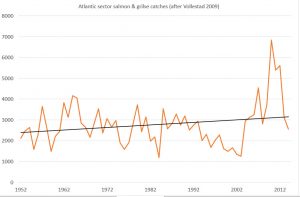
Over the whole time series, there is actually an upward trend, whereas the Vøllestad authors claim that there is a steep decline. I accept that this is presented as a very simplified trend, but it is what it is. The fact is that catches do change from year to year and rivers can produce bumper years of catches just as they can provide a dearth of fish. Every river is different, and this make direct comparison extremely difficult.
The paper also does not mention whether the data includes grilse catches along with those for salmon. The data for salmon and grilse is recorded separately, although I am not sure how anglers can be sure whether the fish they caught is a salmon or a grilse. I suspect that the decision is based on size. My graph includes data for both salmon and grilse.
I have tried to discuss this paper with Marine Scotland Science and recently received a note from Marine Scotland to say that they do not agree with my comments. They say it was appropriate to consider a sample of the rivers within the context of the analyses in the paper. Actually, I don’t disagree.
Where I do take issue is that the authors have then taken a step too far by linking any observed declines in catches with the presence of salmon farming. There have not presented a shred of evidence to support this assertion. As I have already discussed, they have implied a link that does not exist but because they have inferred the link, their work is quoted by other researchers as evidence between falling catches of wild fish and salmon farming.
In fact, Marine Scotland Science have stated in their document on using catch data to measure the impacts of salmon farming that:
It is very important to note that analyses of fishery catches cannot be used to prove whether or not fish farming has an impact on wild fish as there are many other factors that may cause changes in fish populations.
This means that the Vøllestad paper, along with that by Ford and Myers (2008) cannot be used to suggest that salmon farming may have an impact on wild fish populations. Thus, the Summary of Science provided by Marine Scotland Science on the Scottish Government website should be amended to remove these papers. However, the summary has very recently been updated and still includes reference to the Ford & Myers and Vøllestad papers. Given that one of the authors of the Vøllestad papers is still active in Marine Scotland Science, this Is not in the least bit surprising.

